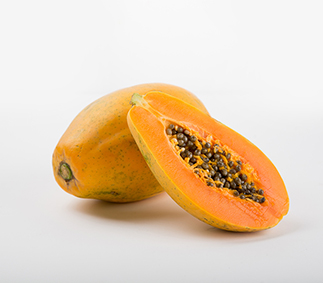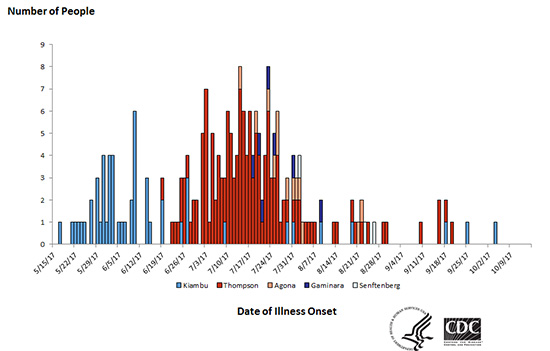2017 Salmonella Infections Linked to Imported Maradol Papayas (Final Update)
Posted November 3, 2017 3:00 PM ET
This outbreak appears to be over. This outbreak was one of four separate multistate outbreaks identified in 2017 linked to imported Maradol papayas from four different farms in Mexico. For information on the other outbreaks, please visit the Reports of Salmonella Outbreak Investigations from 2017 webpage.
- Read the Recall and Advice to Consumers, Restaurants, and Retailers>>
- This outbreak appears to be over.
- CDC, public health and regulatory officials in several states, and the U.S. Food and Drug Administration investigated a multistate outbreak of Salmonella infections.
- Epidemiologic and laboratory evidence indicated that Maradol papayas from the Carica de Campeche farm in Tenabo, Campeche, Mexico were the likely source of this outbreak.
- This outbreak included five types of Salmonella: Thompson, Kiambu, Agona, Gaminara, and Senftenberg. The same strains of these types of Salmonella were found in samples collected from papayas and from ill people.
- A total of 220 people infected with the outbreak strains of Salmonella Thompson (144), Salmonella Kiambu (54), Salmonella Agona (12), Salmonella Gaminara (7), or Salmonella Senftenberg (3) were reported from 23 states.
- Illnesses started on dates ranging from May 17, 2017 to October 4, 2017.
- Sixty-eight ill people were hospitalized. One death was reported from New York City.
Introduction
CDC, public health and regulatory officials in several states, and the U.S. Food and Drug Administration (FDA) investigated a multistate outbreak of Salmonella infections linked to imported Maradol papayas from the Carica de Campeche farm in Mexico.
Public health investigators used the PulseNet system to identify illnesses that may have been part of this outbreak. A total of 220 people infected with the outbreak strains of Salmonella Thompson (144), Salmonella Kiambu (54), Salmonella Agona (12), Salmonella Gaminara (7), or Salmonella Senftenberg (3) were reported from 23 states. A list of the states and the number of cases in each can be found on the Case Count Map page. Whole genome sequencing (WGS) showed that isolates from people infected with Salmonella were closely related genetically. This close genetic relationship means that people in this outbreak are more likely to share a common source of infection.
Illnesses started on dates ranging from May 17, 2017 to October 4, 2017. Ill people ranged in age from less than 1 year to 95, with a median age of 40. Among ill people, 62% were female. Among 169 people with available information, 113 (67%) were of Hispanic ethnicity. Among 170 people with available information, 68 (40%) were hospitalized. One death was reported from New York City.
WGS did not identify antimicrobial resistance genes among isolates from 139 ill people; one ill person’s isolate, a Salmonella Senftenberg, contained a gene known to decrease susceptibility to ciprofloxacin. Standard antibiotic susceptibility testing methods were used by CDC’s National Antimicrobial Resistance Monitoring System (NARMS) laboratory on clinical isolates from 10 ill people in this outbreak and no resistance was detected.
Investigation of the Outbreak
Epidemiologic and laboratory evidence indicated that Maradol papayas imported from Mexico were the likely source of this multistate outbreak.
In interviews, ill people answered questions about the foods they ate and other exposures in the week before they became ill. Of 145 people interviewed, 79 (54%) reported eating papayas. This proportion was significantly higher than results from a survey [PDF – 29 pages] of healthy Hispanic people in which 22% reported eating papayas in the summer months in the week before they were interviewed.
The Maryland Department of Health collected papayas from a grocery store where several ill people reported eating papayas. One sample yielded Salmonella Kiambu and another sample yielded Salmonella Thompson. Both samples were from Caribeña brand Maradol papayas imported from Mexico. WGS showed that the Salmonella Kiambu papaya isolate was closely related genetically to the Salmonella Kiambu isolates from ill people. WGS also showed that the Salmonella Thompson papaya isolate was closely related genetically to Salmonella Thompson isolates from ill people. On July 26, Grande Produce recalled Caribeña brand Maradol papayas that were distributed between July 10 and July 19, 2017.
FDA tested other papayas imported from Mexico and isolated several types of Salmonella, including Salmonella Agona, Salmonella Kiambu, Salmonella Gaminara, Salmonella Thompson, and Salmonella Senftenberg. Through this testing, FDA also identified Maradol papayas from the Carica de Campeche papaya farm in Campeche, Mexico as a likely source of the outbreak. Investigators compared pulsed-field gel electrophoresis (PFGE) and WGS results of Salmonella isolates from the papayas to isolates from ill people in the CDC PulseNet database. These results showed the Salmonella isolates from papayas shared the same DNA fingerprint as the Salmonella isolates from ill people. This result provided more evidence that people in this outbreak got sick from eating contaminated Maradol papayas.
On August 5, Agroson’s LLC recalled certain Cavi brand Maradol papayas grown and packed by Carica de Campeche. On August 7, Freshtex Produce, LLC recalled Valery brand Maradol papayas grown and packed by Carica de Campeche.
This outbreak appears to be over. This outbreak was one of four separate multistate outbreaks identified in 2017 linked to imported Maradol papayas from Mexico. For information on the other outbreaks, please visit the Reports of Salmonella Outbreak Investigations from 2017 webpage.


